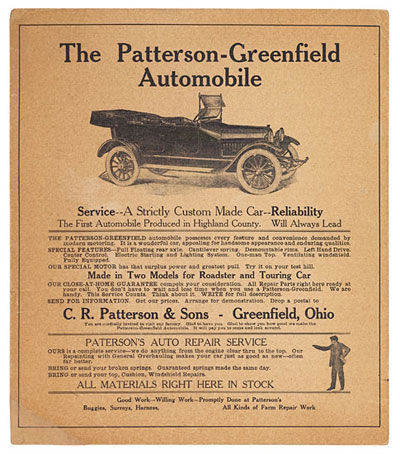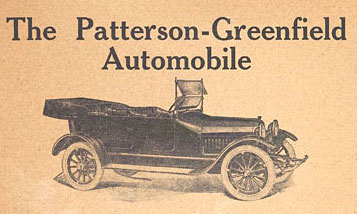One of the highlights of auctions for me is stumbling across history of the contributions of black people to this country. I react with sheer joy because much of it was never written or was lost or was stolen as another’s own or just disappeared.
I made a discovery earlier this week that absolutely thrilled me. I was attending the African American fine arts auction at the Swann Auction Galleries in New York, sitting at a table waiting for a staffer to bring me a James Van Der Zee photograph of a Valentine tea party from the 1920s. I looked up and spotted a fading advertising poster with an antique car on it.
I love antique cars so I was intrigued. The staffer couldn’t find the photo – it was actually hanging on a wall in the gallery – so I asked to see the poster. The photo of the poster above is from the Swann website.
“The Patterson-Greenfield Automobile”
“Made in Two Models for Roadster and Touring Car”
The first and only black car manufacturer near the turn of the century! You’re kidding me! But there it was.
I have come across magazine ads for antique cars at many of my auctions. A couple weeks ago, I blogged about a set of old car ads from the pages of Time magazine from the early 1900s. A month or so ago, one of my favorite auction houses sold old Rolls Royce trophies from 1927.
But never had I come across an ad for this car or even heard of the company. I was in car heaven. Swann had described the poster as “Printed pictorial poster on heavy cardstock. 12×10 inches. Circa 1916-1920. Estimated sale: $3,500-$5,000.”
C.R. Patterson, Son & Company was also the country’s first African American carriage-builder in the late 1800s. Patterson’s background is sketchy, and where he was born and the date of the origin of his company vary depending on who you read.
Here’s what I found, though: Charles Richard Patterson was born in slavery in West Virginia (or Virginia) and is believed to have worked with the plantation’s blacksmith in the smithworks and wagon repair shop, according to the website CoachBuilt. He fled slavery in the 1860s and eventually settled in Greenfield, OH, which was a stop on the Underground Railroad.
Patterson was hired as a blacksmith for Greenfield’s first coach and wagon-maker Dines & Simpson, and eventually became its foreman. In the late 1800s, he bought out another carriage-builder and renamed the company C.R. Patterson, Son & Co., making horse-drawn carriages and buggies. The name was changed to Sons when a second son, Frederick Douglass Patterson (no connection to the famed abolitionist), joined the company after the father became ill.

According to CoachBuilt, the company produced 28 types of vehicles, with prices from $120 to $150 each. Patterson’s buggy was the most popular item and was sold in the South and the Midwest. The company advertised in two black publications – The Crisis (founded in 1910) and Alexander’s Magazine (published from 1905-1909 in Boston).
Frederick Patterson got the idea to go into horseless carriages during a trip at the turn of the century, according to CoachBuilt. Later, when asked why, he said: “In 1902, there was one car to 65,000 people and by 1909 there was one vehicle for every 800 people and with those kinds of figures … I believe it’s time for us to build a Patterson horseless carriage.”
It’s not clear when the company actually began making automobiles. Some accounts say it was 1902, others say 1915. If his quote above is correct, it may have been closer to 1915. The company may have built cars until 1919.
Here’s an account from CoachBuilt (which has some photos of the Patterson car, family members and advertising documents):
“Development of an automobile began in 1914 and the first Patterson-Greenfield rolled out of the company’s Washington St. facility on Sept. 23, 1915. Priced at $850, the Patterson-Greenfield was offered as a touring or roadster and featured a 30hp Continental 4-cylinder engine, full floating rear axle, cantilever springs, demountable rims, electric starting and lighting and a split windshield for ventilation. “
The company is said to also have built a four-door touring car, as noted in the auction poster. It made from 30 to 150 cars. Near its end, it made school buses, trucks, moving vans and hearses. The company closed in the 1930s, and apparently, none of the cars have survived.
As for the auction poster, it sold for $5,200. Someone got a great piece of history.


CR Patterson is my great grandfather. CR Patterson and Sons began manufacturing automobiles in 1915.
The pictures you see that state “Frederick Patterson standing next to a Patterson automobile” is NOT
Frederick Patterson, it is more likely Charles Napper, CR’s grandson, the son of Mary “Maimie” Patterson Napper.
I grew up in Greenfield, Ohio, graduated from Edward Lee McClain High School in 1976. I didn’t hear about this until now. We were taught about the underground railroad in history class and how it goes underneath the city including the school. When I was 13 I babysat for a family who lived in a turn of the century home. They had an access tunnel in their basement that led to the underground railroad. Thanks for sharing your story very interesting part of history that needs to be shared.
Thank you I didn’t Know this.
Hi Sherry. I was amazed to see that the poster was valued so highly at the auction. It is good to see that some folks recognize uniqueness and importance to history when they see it. I happen to know the man in Greenfield who owns the original printers plate from that advertisement. I have included a photograph of it in my newly released book about the history of the C. R. Patterson and Sons Company that was just released on Amazon last week. It can be found at the following link: http://amzn.com/1453770305 Just as previous poster Donna Jackson’ father (Henry May) and myself have both realized, this family and company hold a unique place in American and African American history. Although my version of the story began as a Master’s thesis, it has now been adapted to book form for the public. My original intention was to add technical details of the factory and vehicles to Mr. May’s book and the several articles of the last few decades, but over 2,000 hours of research led me to discover many details of the family and company that had never been discussed before. So I ended up writing a full history of the family and company, including those technical details, from the families arrival in Greenfield in the early 1840s until the factory closed in 1939. I located sources in some very obscure places that have been missed over the years and I feel that anyone interested in this unique history will not be disappointed. The book is 214 pages long and includes several photographs and other illustrations of the family, the factory, and their vehicles. Although several brief articles have been published about the Pattersons through the years, I am glad that Mr. May and myself have seen the importance of this relatively untold history and have made attempts to get the story out there before the story is lost in time. Thanks for mentioning the Pattersons on your blog. It is exposure like this that will help to keep the story alive.
Fantastic, Chris. It’s good to have a definitive history on the Pattersons. It was tough finding accurate information. I’ll be sure to pick up your book.
Sherry
I am so glad I ran across this article because, I love any type of black history it shows that black people had business sense and was intelligent. It’s time that history of black accomplisments be told and written so that our children can read them and not just about white inventors and inventions plus some of the white inventions probably belong to blacks. keep up your good work and finds and alert us us to anything interesting, I love it.
I definitely will, Susie. I had a thrill discovering that bit of black history. It’s the type of thing that I love about auctions. Please keep reading Auction Finds and check out the other bloggers on the site.
Absolutely awesome! What a find! I don’t recall ever hearing anything about black carmakers at the turn of the century, until now. This is a real gem of a find, another piece of forgotten history brought to the light.
Sherry, what I find really unbelievable is that none of the cars have survived. My instincts tell me that someone in the Patterson family held on to one of the cars as a keepsake and it’s tucked away somewhere, perhaps in Greenfield, waiting to be found.
Cortez
Hi Cortez. Let’s hope one of them is around waiting to be “found.”
Sherry
Good morning Sherry,
I hope all is well with you. This is a great find and a great story for all to read. You are doing a great job. Keep the great articles coming. I love reading the articles.
Warm regards,
Donnell
Thanks, Donnell. These types of finds give me particular joy.
Sherry
Wow. I usually keep up with Swann’s auctions, and the moment I turn my head, a wonderful piece of history is sold! I wish I could have won this – my family is related to the Pattersons, and my father wrote a book about them. Whoever the winning bidder is should be very proud, they own an awesome piece of American and African-American history.
Hi Donna. I was really really happy to have come across the poster. It fascinates me to uncover black history and I’m always able to do so at auctions. I didn’t notice the poster on Swann’s website, and just happened to see it in the gallery. You never know: something similar may come up again. That’s the neat thing about auction; the best items do tend to cycle through often. Thanks for commenting and please keep reading the blog. I love writing it.
Take care,
Sherry